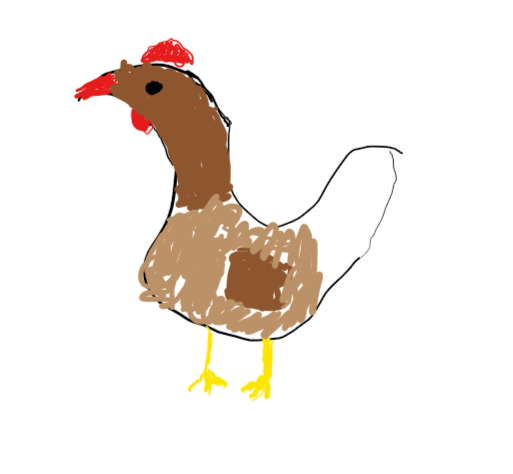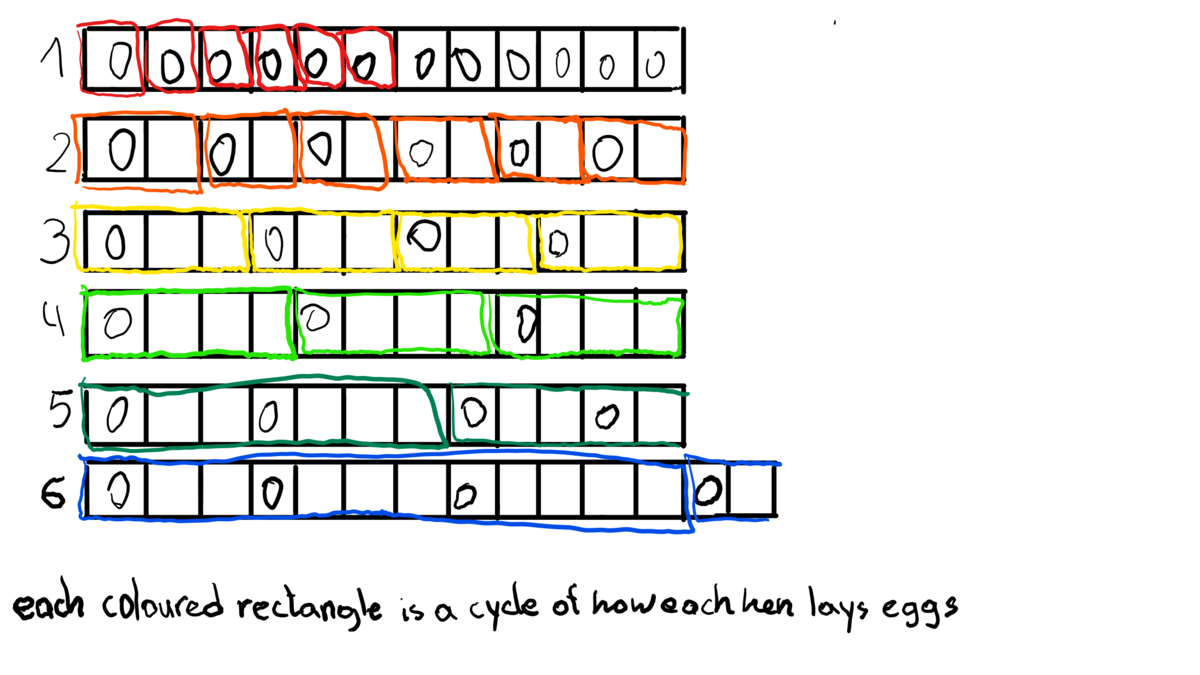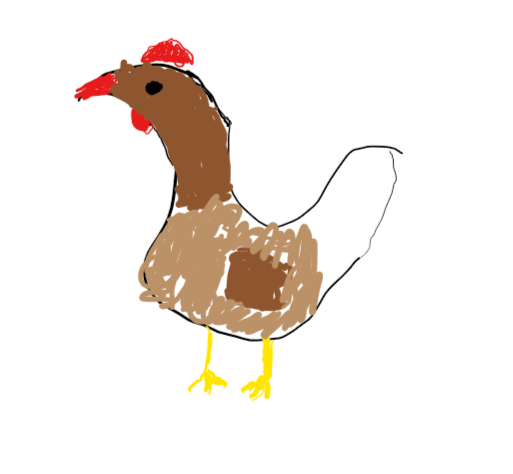Farmer Ram Hens
The farmer Ram has 6 hens:

- The first one lays every day.
- The second one lays every other day.
- The third one lays every third day.
- The fourth one lays every fourth day.
- The fifth one skips two days and lays an egg, then skips three days and lays an egg and the pattern repeats.
- The six one skips two days and lays an egg, then skips three days and lays an egg, then skips four days and lays an egg and the pattern repeats.
How many eggs will the six hens lay for the months J u n e , J u l y and A u g u s t if on the first of June each one laid one egg?
The answer is 243.
This section requires Javascript.
You are seeing this because something didn't load right. We suggest you, (a) try
refreshing the page, (b) enabling javascript if it is disabled on your browser and,
finally, (c)
loading the
non-javascript version of this page
. We're sorry about the hassle.
3 solutions
There are 30 + 31 + 31 = 92 days in the months June, July and August.

The first one lays 92 : 1(day in one cycle) = 92 full cycles 92 * 1(egg in one cycle) = 92 eggs
The second one lays 92 : 2(days in one cycle) = 46 full cycles 46 * 1(egg in one cycle) = 46 eggs
The third one lays 92 : 3(days in one cycle) = 30 full cycles and 2 days left which cover additional 1 egg 30 * 1(egg in one cycle) + 1 = 31 eggs
The fourth one lays 92 : 4(days in one cycle) = 23 full cycles 23 * 1(egg in one cycle) = 23 eggs
The fifth one lays 92 : 7(days in one cycle) = 13 full cycles and 1 day left which cover additional 1 egg 13 * 2(eggs in one cycle) + 1 = 27 eggs
The sixth one lays 92 : 12(days in one cycle) = 7 full cycles and 8 days left which cover additional 3 eggs 7 * 3(eggs in one cycle) + 3 = 24 eggs
92 + 46 + 31 + 23 + 27 + 24 = 243 total eggs from the six hens

Let us define an egg-laying function e ( n ) for the number of eggs laid in n days. For simple egg-laying cycle or period of 1, 2, 3, 4 ... p days such as those for the first four hens, assuming an egg is laid on the first day of the cycle, we have e ( n ) = ⌈ p n ⌉ , where ⌈ ⋅ ⌉ denotes the ceiling function . For the fifth hen, the egg-laying function is slightly modified to e 5 ( n ) = ⌈ 7 n ⌉ + ⌈ 7 n − 3 ⌉ . Similar for the sixth hen, e 6 ( n ) = ⌈ 1 2 n ⌉ + ⌈ 1 2 n − 3 ⌉ + ⌈ 1 2 n − 7 ⌉ . Therefore, for the all six hens:
e 6 hens ( n ) = e 1 ( n ) + e 2 ( n ) + e 3 ( n ) + e 4 ( n ) + e 5 ( n ) + e 6 ( n ) = ⌈ 1 n ⌉ + ⌈ 2 n ⌉ + ⌈ 3 n ⌉ + ⌈ 4 n ⌉ + ⌈ 7 n ⌉ + ⌈ 7 n − 3 ⌉ + ⌈ 1 2 n ⌉ + ⌈ 1 2 n − 3 ⌉ + ⌈ 1 2 n − 7 ⌉
For n = 9 2 :
e 6 hens ( 9 2 ) = ⌈ 1 9 2 ⌉ + ⌈ 2 9 2 ⌉ + ⌈ 3 9 2 ⌉ + ⌈ 4 9 2 ⌉ + ⌈ 7 9 2 ⌉ + ⌈ 7 9 2 − 3 ⌉ + ⌈ 1 2 9 2 ⌉ + ⌈ 1 2 9 2 − 3 ⌉ + ⌈ 1 2 9 2 − 7 ⌉ = 9 2 + 4 6 + 3 1 + 2 3 + 1 4 + 1 3 + 8 + 8 + 8 = 2 4 3
There are 9 2 days total in the months of June, July, and August.
H e n 1 = 1 × 9 2 = 9 2
H e n 2 = ( 1 + 0 ) × 2 9 2 = 4 6
H e n 3 = ( ( 1 + 0 + 0 ) × ⌊ 3 9 2 ⌋ ) + ( 1 + 0 ) = 3 1
H e n 4 = ( 1 + 0 + 0 + 0 ) × 4 9 2 = 2 3
H e n 5 = ( ( 1 + 0 + 0 + 1 + 0 + 0 + 0 ) × ⌊ 7 9 2 ⌋ ) + ( 1 ) = 2 7
H e n 6 = ( ( 1 + 0 + 0 + 1 + 0 + 0 + 0 + 1 + 0 + 0 + 0 + 0 ) × ⌊ 1 2 9 2 ⌋ ) + ( 1 + 0 + 0 + 1 + 0 + 0 + 0 + 1 ) = 2 4
9 2 + 4 6 + 3 1 + 2 3 + 2 7 + 2 4 = 2 4 3